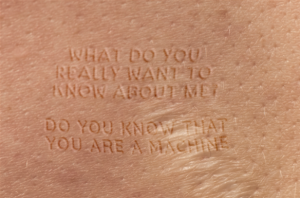Continuing my previous blog, I will delve a bit deeper into the current technological developments, the topic of merging with our machines, and possible future implications. I cannot predict the future, but taking a look at the current situation might give some hints. To me, it is important to try to envision different scenarios, and this blog is way too short to discuss the subject broadly. Note that I am not taking certain socio-political as well as environmental situations into account, which I obviously don’t mean to deem unimportant. It might be that certain political situations block or even motivate certain developments, that we run out of important resources or any kind of event happens that might block or stimulate us.
Uncanny?
Google has recently announced the coming of Google Duplex, a virtual assistant which can imitate a human so realistically (‘hmm’s and ‘uh’s included), it can e.g. make a restaurant reservation for you without the person on the phone noticing he or she is talking to an AI. If in our experience it is becoming harder to tell the difference between a bot and a human, how much difference is there really? And does that pose any problems, or does it simply feel eerie? Welcome, I think we have arrived in the uncanny valley.
In the previous blog, I have talked about trust and the potential for deception. Many people worry that an AI’s ability to deceive humans is a dangerous feature. Actually, this deception is already starting to be quite problematic: on the internet we cannot easily distinguish bots from humans anymore, because we roam the net without using our body. We might realize that there may not be that much perceived difference between a human (perhaps hard to admit, but basically a complex biological robot) and an actual well-developed bot. Also, people are more willing to trust and obey an AI/bot than a human, as it perhaps appears to be more objective. But we must not forget that they are created by humans, and thus have human wishes, flaws and biases built into them.
Reports have shown that perhaps over half of all internet traffic might be non-human. Bots on Facebook and Twitter are often unnoticed by the bot detection mechanisms and are capable of posting, commenting, spreading fake news and thus influencing public opinion (astroturfing). Some people have been scammed by sex-chatbots, and there has even been a bot on Reddit that earned cryptocurrency simply by commenting inspiring quotes until people unmasked it as a bot.
So as we are ‘merging’ more and more with our machines, it might also become more important to emphasize our differences to preserve our identity and autonomy. I foresee a needed potential development of better, securer systems and perhaps even laws concerning the authentication and identity disclaimers of humans and bots.
Automation
Another important subject to take into account is the automation of jobs. It is estimated that by 2030, up to 800 million workers will be replaced by technology. Of course, tasks requiring human interactions are less prone to automation. But as the developments continue and conversational bots are becoming more human-like (as seen in Google Duplex), even this is not so sure anymore.
To take a more positive perspective: there is a clear rise in cooperation with technology. Jobs might be taken but many services will be improved by the use of (chat)bots, ones that we trust. An evident example is healthcare, a field in which much progress is already visible. For example, there are robot-companions being developed that might aid elderly struggling with Alzheimer’s by communicating with them. Virtual assistants, linked to extensive knowledge databases, are helping not only patients but also doctors to educate, diagnose and treat more efficiently. Kids are taught more playfully about their health through the use of conversational agents, making hospital visits less intimidating. Other potential purposes/functions that we might see more available in the future include combatting loneliness in the elderly, aiding people having difficulties with socializing and even giving a voice to the often unheard. Virtual assistants will likely seep into our lives more and more, and one could even imagine brain-computer interfaces in the foreseeable future, where the AI would not be an external assistant anymore, but a very literal extension of your brain.
Things are changing, and although change can be scary, I hope you can see that even though we need to be wary, there are many positive developments in technology. There are two sides on the same coin of trust. The tension seems to be there where the border between humans and technology dissolves. I deem it important to reevaluate what it means to be, what it means to be human, what our ethics are and what we want for our future. We need to make sure that we raise our people and our bots right. If we can align our wishes interpersonally, we can align them with our technology.
Further Reading:
- Report: Bot traffic is up to 61.5% of all website traffic
- Reverse Engineering Socialbot Infiltration Strategies in Twitter
- Astroturfing, Twitterbots, Amplification – Inside the Online Influence Industry
- Twitter bars tactics used by ‘bots’ to spread false stories
- Bot-o-Meter (formerly Bot or Not?)
- McKinzey report: Jobs lost, jobs gained: What the future of work will mean for jobs, skills, and wages
- Will Robots Take My Job?
- A Robot-Companion for Senior People and Patients with Alzheimer’s Disease
- Using IBM Watson cognitive technology to enhance the young patient experience
- Ustwo creates NHS app to ‘distract’ children in hospital
- Your Virtual Medical Assistant
- UNICEF: Helping Marginalized Communities Be Heard
- U-Report Liberia exposes Sex 4 Grades in school.
- The AI Alignment Problem: Why It’s Hard, and Where to Start
Episodes:

